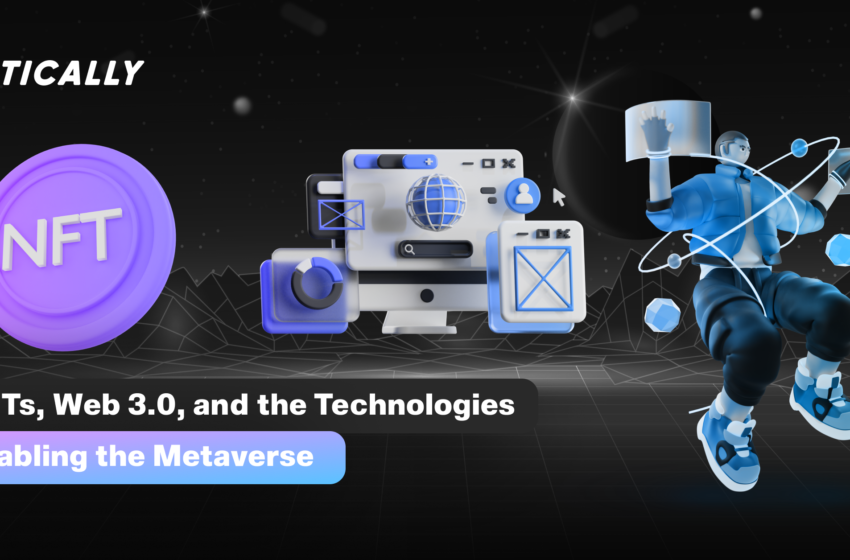DTCC Pushes U.S. Treasurys On-Chain as Tokenization Becomes Core Market
Enabling the Nfts Web 3.0 and Providing User a Digital Space
(Originally posted on : NFTICALLY )
Our world is full of data but data does not belong to the people. For instance, governments maintain land ownership records and electoral details of the population. Likewise, private corporations track our digital footprints on the internet and monetize them. You must have noticed search engines and social media websites. They manage to show you sponsored posts and products to make you click on them. This is by design. Hence, people who gave away personal and professional data do not get to own our data. NFTs, Web 3.0, and the technologies enabling the metaverse promise to make people and data free.
The first question we’ve to ask ourselves is, how did we get here? What happened in the last 30 years in internet technology? Private and public land ownership forms the basis of the physical economy. Industries, capitalists, and labor represent the foundations of political governance. Hence, how did electronic means of communication and information sharing come to dominate? Hence, why will NFTs, Web 3.0, and the technologies enabling the metaverse become the future? Let’s find out.
Electricity and Mobile Internet Adoption
The spread of electrical technology is the most important thing to understand. For instance, when electric power stations were built in the late 19th century, it took another 30 years for industrial adoption. Everyone thinks that once Thomas Edison patented the electric bulb, electricity had arrived. This is far from the truth. Like every new technology, electricity saw its fair share of skeptics and pessimists. Only, from the 1920s onwards, did the technology become common.
Likewise, the case with the internet is a software phenomenon. It was only when hardware component makers and telecommunications infrastructure reached major cities. We associate mobile internet with the arrival of the iPhone. But, we know mobile devices since the 1990s. Remember Blackberry, Nokia, and Motorola? Web 1.0 took off in the 1990s. Likewise, with mobile internet came major Web 2.0 adoption. This is the era of social media, e-commerce, and platform businesses. Today, there are approximately 4 billion internet users. Web 3.0 is upon us. It arrived with the Bitcoin whitepaper in 2009.
NFTs, Web 3.0, and the technologies enabling the Metaverse
We’ve developed a better understanding of what goes into technology adoption. The development of technology changes human culture and social dynamics in many ways. It rewires entire lifestyles since people become familiar with new habits. Technology makes them understand over time. For instance, the Metaverse will not replace the existing internet. Instead, it will make the internet better and more immersive. People will find new ways to use the internet, the likes of which we cannot even think about now. Hence, let’s begin to learn about NFTs, Web 3.0, and the technologies enabling the Metaverse in detail.
Hardware
A majority of internet data travels through fixed physical infrastructure. For instance, your mobile data. Telecom companies build mobile towers in every city and town. Likewise, there are massive undersea cables that transmit data from one corner of the world to another. Remember broadband connections with ethernet cables that need to be physically connected to your desktop via local telephone lines? Yes, that’s internet hardware. Likewise, modems, routers, and switches. A massive amount of investment has gone into getting internet data onto our phones and computers. Hence, the metaverse will require the same.
Think 5G and above technology, GPUs, VR/AR-enabled devices, industrial grade cameras, tracking systems, and scanning sensors.
Networking and Computing
These two technologies enabling the Metaverse seem to fly under the radar of most people. However, their importance will determine what we can and cannot build. Networking consists of two important things – bandwidth, latency, and reliability. Bandwidth is the amount of data we can send over a unit of time. Hence, owing to the immersive nature of the metaverse, we need lots of bandwidth as compared to the applications we use today. For instance, when we stream games, most of the data is already on our phones, while the games send over positional data via the internet. Hence, the download and installation times we know.
Likewise, latency is the amount of time it takes for data to travel to one point and come back. It’s the most difficult issue to solve when it comes to metaversal applications. For instance, metaverse applications are both social and technological. This means any time delay in application experience will curtail user experience. Today, many feel frustrated because their videos take time to load. Imagine how this frustration will multiply when it comes to the metaverse. For instance, 5G helps in reducing latency over 4G by orders of magnitude. The metaverse will require the largest computational requirements in human history. Decentralized storage and computing is scalable via blockchain technology since any idle hardware space in the world is available for use in the market.
The Platforms: Combining NFTs, Web 3.0, and the Metaverse technologies
At the end of the day, people want to get things done. Everyone wants to live, love, connect with others, have fun and earn money. Hence, how can NFTs, Web3.0, and the technologies that enable the Metaverse do this? Web 2.0 giants like Google and Facebook have come to be de facto leaders in search and social media. We’ll see the rise of platforms that help people and businesses to get their things done as fast as possible. In fact, this will be much bigger than all technological shifts. Once people get the ability to own in-application items as NFTs, there’s higher motivation. People will work for the projects they care most about.
Conclusion
We’re at the dawn of a big shift in our socio-economic lives. Physical borders do not matter as much as it used to before. The internet has created a level playing field for talent and skills from all over the world. People need to take the initiative to understand how the world is moving to this future and take action as fast as possible. NFTs, Web 3.0 and the technologies that enable the metaverse will change the way we think about the world.
NFTICALLY is a venture that helps brands, creators, and enterprises to create and launch their own NFT marketplaces.








 Bitcoin
Bitcoin  Ethereum
Ethereum  Tether
Tether  XRP
XRP  USDC
USDC  TRON
TRON  Lido Staked Ether
Lido Staked Ether  Dogecoin
Dogecoin  Figure Heloc
Figure Heloc  Cardano
Cardano  WhiteBIT Coin
WhiteBIT Coin  Bitcoin Cash
Bitcoin Cash  Wrapped stETH
Wrapped stETH  Wrapped Bitcoin
Wrapped Bitcoin  USDS
USDS  Binance Bridged USDT (BNB Smart Chain)
Binance Bridged USDT (BNB Smart Chain)  Chainlink
Chainlink  Wrapped eETH
Wrapped eETH  Monero
Monero  WETH
WETH  Stellar
Stellar  LEO Token
LEO Token  Hyperliquid
Hyperliquid  Ethena USDe
Ethena USDe  Coinbase Wrapped BTC
Coinbase Wrapped BTC  Zcash
Zcash  Litecoin
Litecoin  Sui
Sui  Avalanche
Avalanche  sUSDS
sUSDS  Hedera
Hedera  Shiba Inu
Shiba Inu  Dai
Dai  USDT0
USDT0  Mantle
Mantle  PayPal USD
PayPal USD  Toncoin
Toncoin  World Liberty Financial
World Liberty Financial  Cronos
Cronos  Ethena Staked USDe
Ethena Staked USDe  Uniswap
Uniswap  Polkadot
Polkadot  MemeCore
MemeCore  Canton
Canton  USD1
USD1  Aave
Aave  Rain
Rain  Bitget Token
Bitget Token  Tether Gold
Tether Gold  Bittensor
Bittensor  OKB
OKB  Falcon USD
Falcon USD  NEAR Protocol
NEAR Protocol  Ethereum Classic
Ethereum Classic  Jito Staked SOL
Jito Staked SOL  BlackRock USD Institutional Digital Liquidity Fund
BlackRock USD Institutional Digital Liquidity Fund  Pi Network
Pi Network  Binance-Peg WETH
Binance-Peg WETH  Aster
Aster  syrupUSDC
syrupUSDC  Pepe
Pepe  Internet Computer
Internet Computer  Solana
Solana  Ethena
Ethena  Jupiter Perpetuals Liquidity Provider Token
Jupiter Perpetuals Liquidity Provider Token  HTX DAO
HTX DAO  PAX Gold
PAX Gold  Global Dollar
Global Dollar  Circle USYC
Circle USYC  KuCoin
KuCoin  Sky
Sky  Ripple USD
Ripple USD  syrupUSDT
syrupUSDT  BFUSD
BFUSD  Binance Bridged USDC (BNB Smart Chain)
Binance Bridged USDC (BNB Smart Chain)  Ondo
Ondo  Worldcoin
Worldcoin  Pump.fun
Pump.fun  Gate
Gate  Rocket Pool ETH
Rocket Pool ETH  Binance Staked SOL
Binance Staked SOL  Wrapped BNB
Wrapped BNB  POL (ex-MATIC)
POL (ex-MATIC)  Aptos
Aptos  Quant
Quant  Arbitrum
Arbitrum  Official Trump
Official Trump  Midnight
Midnight  Algorand
Algorand  Function FBTC
Function FBTC  Solv Protocol BTC
Solv Protocol BTC  Lombard Staked BTC
Lombard Staked BTC  Liquid Staked ETH
Liquid Staked ETH  Cosmos Hub
Cosmos Hub  NEXO
NEXO